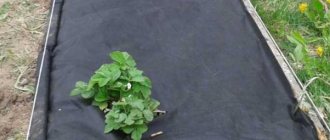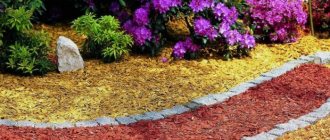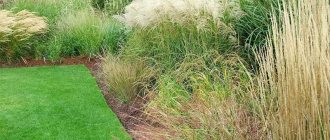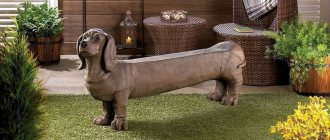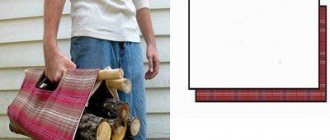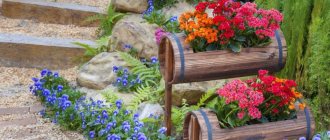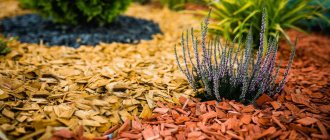Decorative wood chips are natural raw materials created on the basis of wood. On the market it is famous primarily for its environmental friendliness and safety. Most often, decorative wood chips are used in landscape design. There are double benefits from its use: an aesthetically beautiful appearance of the site and practical benefits, since it is almost impossible for weeds to grow in places where decorative wood chips are mounded.
Brown wood mulch in landscaping
Its practical application does not require special skills from the gardener. A little imagination, desire and materials will highlight the abundance of your site. Decorative wood chips are used to decorate flower beds, sprinkle soil in front gardens, mark paths, and create fancy patterns or pictures in areas of poor and infertile soil to hide the imperfections of the site.
Decorative wood chips for landscape design
In this article we will take a detailed look at all the advantages of decorative wood chips, learn the technology of its production and even how to make your own colorful mulch.
What are the advantages?
This type of filling has a number of advantages:
A rich range of colors allows you to create different decorative effects, patterns and even paintings.
The material is environmentally friendly, making its use safe for the environment. Please note that high-quality wood chips do not fade in your hands, and natural or low-toxic dyes should predominate in its composition.
The material retains moisture for a long time and also protects the soil from weathering, overheating, compaction, and the garden from weeds and cold weather.
Easy care. To update areas decorated with sawdust, just pour a new layer on top of the old one and distribute it evenly.
Availability. You can buy wood chips at a relatively low price, or you can make it yourself.
Is it safe?
Theoretically, every manufacturer of this type of product is required to disinfect wood chips or crumbled bark by drying and steaming. Usually this is enough to destroy any pests and plant pathogens present in it at all possible phases of their development. In addition, even wood inhabited by harmful insects, after grinding and drying, usually ceases to be suitable for them as a habitat. And if the wood chips are stained, the pests have no chance of survival at all.
Article on the topic
The evolution of fertilizers. What fed the soil in the 19th century
But it should be remembered that even on disinfected chips or bark there may remain clear evidence of the past activity of bark beetles, longhorned beetles, borers, wood borers, etc., as well as traces of wood decomposition by wood-destroying fungi.
Application area
The use of decorative wood chips in landscape design is possible for a variety of purposes.
It is recommended to use it to decorate flower beds, garden paths, playgrounds, and individual areas of the garden: lawns, embankments, multi-level slopes.
The composition of the mixture and the methods of its installation depend on what exactly will be decorated with the filling of wood chips.
Flower beds and flower beds
To decorate flower plantings, colored and natural chips from deciduous trees are used.
First, weeds, fallen leaves and other debris are removed from the soil around the flowers. Then the ground is loosened and marked. To do this, partitions are created from sheets of cardboard - the outline of the future design.
Afterwards, the resulting parts are filled with filling according to the sketch, and the cardboard is removed. The thickness of the filler layer is from 4 to 10 cm. The drawing is ready.
For a one-color design, there is no need to mark the territory. Some gardeners lay agrofibre under the wood chips, which reduces the consumption of fill per square meter. The recommended thickness of the sawdust layer in this case is 2-5 cm.
It is recommended to leave a small area around plants and bushes without sawdust. In the future, this will simplify root feeding of flowers and caring for them in general.
Around the trees, on the contrary, it is necessary to lay out circles of wood chips, which will increase the fertile qualities of the soil.
Multi-colored decorative wood chips look good in combination with lush flowering varieties of ornamental plants, and for laconic coniferous hills it is better to choose natural shades of sawdust from coniferous trees.
The effect of sawdust on the soil: benefit or harm?
Sawdust affects not only the plant, but also the soil underneath it. This type of fertilizer has a number of advantages and relative disadvantages, which can be eliminated if used correctly.
Sawdust affects not only the plant, but also the soil underneath it.
Among the advantages of sawdust:
- it is possible to prepare traditional high-quality humus in a short time;
- preventing weed growth;
- maintaining soil moisture in spring;
- reduced risk of plant infection when using softwood sawdust.
But sawdust also has disadvantages, but you can correct them yourself and avoid making mistakes when fertilizing plants. To do this, it is worth remembering such features of the material as:
- In its pure form, sawdust cannot be used as fertilizer. Wood draws nitrogen from the soil, depleting its composition;
- fresh wood has an oxidizing effect, which not all plants will like, so lime is often added to sawdust;
- unknown material can infect plants with bacteria, so it is important to use proven sawdust.
Paths
Colored sawdust is ideal for making garden paths: grass will not grow on them, it is comfortable to walk on them, moisture does not linger on such paths and quickly goes into the ground.
Despite this, when decorating paths with wood chips, you need to take into account a number of nuances.
Firstly, it is not recommended to completely cover paths that are often used with sawdust - they quickly get trampled down and lose their decorative appearance. Instead, it is better to lay out a path made of natural stone, and fill in decorative chips in between.
Secondly, to prevent the solid path from being washed away by rain and blown across the entire area by the wind, edges are installed along the edges of wood chip paths. The sides can be hidden or obvious - in accordance with the designer’s idea.
If the design involves hidden sides, then the path must first be deepened by 2 cm (without taking into account the thickness of the mulch layer).
The thickness of the wood chip layer can also vary between 5-10 cm.
Thirdly, in order to improve the performance characteristics of the path, the place prepared for backfilling is covered with geotextiles and a thin cushion of sand is placed on it.
Laying woodchip mulch
When choosing a decorative material, pay attention to the size; it is usually indicated on the packaging. The filling should also be soft and moist. Laying wood chips is easy; start the process in late spring or early fall.
If you are going to make a pattern of different colors, then the area needs to be marked in advance. Remove debris, branches and leaves from the soil, and then loosen it and you can add fertilizer and don’t forget to water. It is best to lay mulch in sunny weather.
The layer of material can be more than 5 cm, depending on where it will be, in the shade or in the sun. When laying, leave a gap near the main stem so as not to disturb air circulation.
Chips can be laid out on open soil; to save on material, you can use agrofibre, which can slow down the growth of weeds.
Garden playgrounds
A small playground can be decorated with a covering of multi-colored wood chips. The bright colorful ornament is sure to attract the attention of kids.
Wood chips are made from soft coniferous trees, so the coating of them will not cause any harm to children, on the contrary, it will protect them from possible minor injuries if they fall.
For children's playgrounds, it is recommended to select high-quality wood chips, tinted using natural dyes.
Design of slides and slopes
To decorate hills, slopes and multi-level compositions with decorative wood chips, mulch options with large fractions are used.
In this case, sides must be laid along the contour of the area to be filled.
Mulch can become an alternative to the lawn in areas that are difficult to plant lawn grass, but then its presence will have to be diluted - part of the composition will have to be laid out with decorative gravel or stone.
Decorative wood chips are a durable, environmentally friendly and beautiful material. With proper care and proper design, wood chip decor will delight the eye for many seasons in a row.
Prices
Nothing would be a pity for your beloved garden! This is the motto of many summer residents and owners of country houses. You don't have to spend crazy money to mulch the soil.
Using marble chips is, of course, a more expensive option, but most types of mulch are affordable for many.
Compare prices:
- pine bark (bag, volume 50 l) - 50-70 rubles;
- organic mulch (produced using equipment from the USA) - for a volume of 50 liters - 347 rubles;
- colored organic mulch (in a 50-liter bag) – 347 rubles;
- decorative wood chips (bag, volume 50 l) - 161-210 rubles;
- zeolite crumb. Green color. 10 rub. for 1 kg;
- marble chips (white) - Fraction 3-5. Volume – 12 l. 347 rub. per packaging;
- marble chips. Color – cream – 6.5 rub. for 1 kg;
- quartzite chips. Color – red. – 9 rub. kg;
- colored wood chips – 347 rubles per bag (50 l);
- pine crumbs for orchids (bag, volume 1 l). Price 15 rub.
